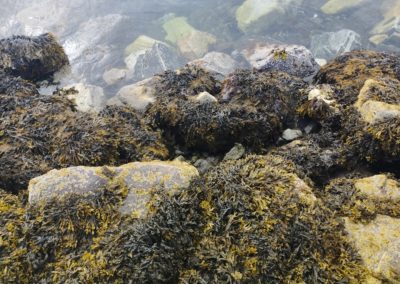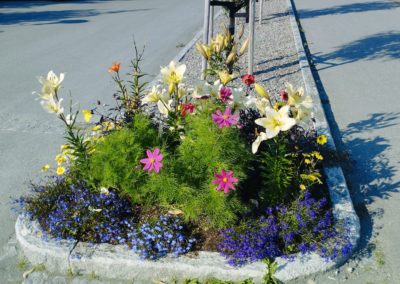Larisa Crunteanu
Travel Journal

Biography
Larisa Crunțeanu studied Photography and Dynamic Imaging, with a PhD at the University of Art in Bucharest. The artist works with video and performance, at the intersection of research and exploration, often in collaborative projects, creating contexts for the development of new artistic practices. Her work has been part of important exhibitions such as her solo-show at the National Museum of Contemporary Art, as well as group and solo exhibitions in Berlin, SAVVY Contemporary, Zacheta Project Room Warsaw, RKI Berlin, Museu de Arte Brasieira – MAB FAAP, São Paulo Her work has been exhibited in institutions such as the National Museum of Contemporary Art in Bucharest, SAVVY Berlin, Zacheta Project RoomWarsaw, RKI Berlin, Museu deArte Brasieira – MAB FAAP, São Paulo. His works are part of important exhibitions and events such as: 2021, One day the day will come when the day will not come, Art Encounters Biennial 2021, Timișoara; 2020-2021, DO IT BY HEART, National Museum of Contemporary Art, Bucharest; 2021, Image Fantome, Anca Poterașu Gallery, Bucharest; 2020-2021, 12 YEARS AFTER. A SURVEY OF ROMANIAN ART IN 180 WORKS, MNAC Bucharest; 2020, Les Films de Cannes à Bucarest, Bucharest;2020, New East Poetistas, Alte Feuerwache-Projektraum, Berlin; 2020, A Room Full of Hysterical Women, Artissima Fondamenta, Torino; 2020, The Winner Takes It All, Montez Press Radio, New York; 2020, Wish, wishing and some associations to that, Radio Corax, Halle; 2020, A Room of One’s Own, Anca Poterașu Gallery, as part of NADA New York Gallery Open, Catinca Tăbăcaru Gallery, New York; 2020, R. A.B.L.A. (Random Archives & Basic Loop Activators), kinema ikon, Arad Art Museum, Arad; 2019, Artissima Telephone, OGR Torino; 2019, A Room Full of Hysterical Women, Artissima ArtFair, Torino; 2019, BLUEPRINT, HALLE9 Leipzig; 2019, Keep Forgetting to Forget Me, Anca Poterașu Gallery, Spinnerei Leipzig;2019, ULTRASANITY, Savvy Contemporary and ifa Galerie, Berlin; 2019, Foreign Artists in Warsaw, Warsaw Biennale, Warsaw; 2018,
Aria Mineralia, Anca Poterașu Gallery Bucharest; 2018, Aria Mineralia, Zacheta Project Room Warsaw; 2018, A Small Insignificant Love, tete Berlin;2018, A Small Insignificant Love, INDEX Foundation, Stockholm; 2017, Souvenir from Nowhere, Museu de Arte Brasileira – MAB FAAP, São Paulo; 2017, Seeds (Planted By Other Women Inside My Head), RKI Gallery, Berlin; 2016, D’EST Prologue, Martin Gropius Bau, Berlin; 2016, Public Speaking – with Sonja Hornung, District Berlin, Berlin; 2015, Femina Subtetrix – with Sonja Hornung, Ivan Gallery, Bucharest; 2013, BwO, Atelier 35, Bucharest; 2014, What about Y(our) Memory – with Xandra Popescu, MNAC, Bucharest;2014, SalonVideo – with Xandra Popescu, HAU, Berlin; 2013, Dear Money – with Xandra Popescu, Project
Salon, Vienna Art Fair, Vienna; 2013, Good Girls, National Museum of Contemporary Art, Bucharest; 2012, I Hear Bucharest – with Larisa David, Galeria Posibilă, Bucharest; 2012, Casti.
Photo credit: Larisa Crunteanu

Residency
20 – 25 July
Norway, Tromso
20 July
Visit to the University of Tromso’s
Herbarium section with researcher Heini Rämä The building houses some 280 000 objects, mostly from northern Norway and the circumpolar boreal and arctic regions. About 90% of the collections are already digitised and can be searched through the Global Biodiversity Information Facility (GBIF) and the Centre for Biodiversity Information (CBI) portals of the Norwegian Biodiversity Information Centre (NBIC), as well as the TROM search portal of the Norwegian Biodiversity Information Centre (NBIC). The TROM herbarium has collections of vascular plants, bryophytes, algae, lichens and fungi. In addition, there are smaller collections that have not yet been recorded, e.g. seeds, pollen, other botanical objects and ethnobotanical items, as well as DNA samples. Approximately 8 000 plant collections from the Tromsø Arctic-Alpine Botanic Garden are included in a separate database.
—
Visit to the Arctic University Museum
This museum offers science-based exhibits updated with the latest research. From fossils and rocks to wildlife and changing nature, the “TellUs” and “UnNaturally” nature exhibits provide comprehensive information about the history of our planet Earth, as well as the evolution and adaptation of birds and animals in the northern regions. A giant ichthyosaur fossil, a whale skeleton and a massive gold nugget are among the museum’s highlights.
—
Sound walk
With Inga Bardsen Tollefsen, sound researcher and conductor, in the Kvaløysletta and Kaldfjord region. The aim of the walk was to listen to the natural and modified sound of non-invasive organic farming. The term “sound walk” was first used by members of the World Soundscape Project under the direction of composer R. Murray Schafer in Vancouver in the 1970s, and our coordinator worked hard to create a rhythm and attention to sounds with Nordic timbres and specificities.
21 July
Hiking the Sherpa Steps trail
The hike follows a clearly marked trail that includes 1300 stone steps painstakingly constructed by Nepalese Sherpas. Beginning with a serene walk through dense forest, the hike passes halfway through the hike into an area where no trees grow, offering views of the breathtaking natural beauty of the Arctic Circle. The adventure persists until you reach an altitude of 421 metres.
Along the way, we stopped for an imaginative guided ethnography exercise called Plant Meditation
22 July
Sound walk along the coast, following the directions in the brochure provided by Arctic Auditories. It ended at the Arctic University Museum with a discussion in which a series of questions about the environment and bird life in the area, asked at the start of the walk, were taken back to provide possible answers and personal reflections.
Audio and video recordings in two areas of the city, an overcrowded area where life is heavily affected by traffic and terraces, and a natural area where gulls spawn and
and teach their young to fly.
23 July
Working session to draw up the exhibition plan and timetable.
Group visit to the Polar Museum in Tromsø
After being established as the “Gateway to the Arctic” in the late 19th century, Tromsø became a base for many polar expeditions. The Polar Museum preserves and recounts this aspect of Tromsø’s and the Arctic’s history. The Polar Museum’s permanent exhibitions cover seal hunting, winter hunting, the stories of famous hunters such as Henry Rudi and Wanny Wolstad, the expeditions of Fridtjof Nansen and Roald Amundsen. Wonderfully set in an 1830s warehouse, stored on the waterfront.
Trip to Presvannnet for new audio and video recordings.
24 July
Visit to the Northern Norway Science Centre – exhibitions and planetarium
The institution aims to improve understanding of the universe, weather phenomena in climate, energy, physics and the human body. Through interactive exhibitions you can explore the different layers of the atmosphere in the Northern Lights lift, the force of the wind experienced by a skier descending the valley or the energy production needed for different daily activities.
The exhibits and texts available in the institute reflect the northern location, energy and environment, the sky, the climate and the human body.
The science centre is also home to Norway’s largest planetarium, where the aurora is never missing and no other natural phenomenon does better to be presented in a 360° dome theatre. During our visit to the planetarium we watched the film Extreme Aurora.
The project “Blue Sun – Conversation on art, science, and ecology” benefits from a 93960 Euro grant from Iceland, Liechtenstein and Norway through the EEA and Norway Grants.
The EEA and Norway Grants represent the contribution of Iceland, Liechtenstein and Norway towards a green, competitive and inclusive Europe. There are two overall objectives: reduction of economic and social disparities in Europe, and to
strengthen bilateral relations between the donor countries and 15 EU countries in Central and Southern Europe and the Baltics. The three donor countries cooperate closely with the EU through the Agreement on the European Economic Area (EEA). The donors have provided €3.3 billion through consecutive grant schemes between 1994 and 2014. For the period 2014-2021, the EEA and Norway Grants amount to €2.8 billion. More details are available on: www.eeagrants.org and www.eeagrants.ro



































